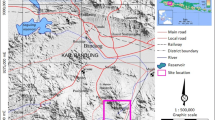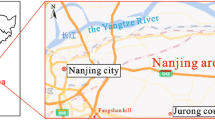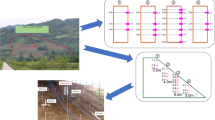Abstract
Local collapse or even overall movement may occur due to excavation at the slope toe, especially when there is a weak interlayer in the stratum. This process frequently produces many tension cracks on the slope surface, increases the sensitivity of groundwater to rainfall and thus promotes the development of landslide. The Houpucun landslide, which is located in Tonglu County, Zhejiang Province of China, is a typical case in which the weak interlayer and the tension crack play an important role in triggering the slope instability. In this study, the deformation process and the hydraulic characteristics of this landslide were analyzed based on monitoring of the slope displacement, rainfall and hydraulic head. The results show that the slope deformation has a strong correlation with rainfall and groundwater table. The large number of cracks on the slope surface provide favorable conditions for the infiltration of rainfall and that the hydraulic head rise rapidly under the action of rainfall. Because the mechanical strength of the weak interlayer greatly decreases when saturated, the slope is prone to failure under rainfall. Numerical simulations were carried out to compare the stability of the slope before and after rainfall. The results show that the factor of safety of the slope is close to one once the weak interlayer is immersed by groundwater. A new siphon drainage technique was employed to control the groundwater table and improve the stability of the slope, which has proven to be a practicable and efficient countermeasure for the case in hand.












Similar content being viewed by others
References
Al-homoud AS, Tubeileh TK (1998) Analysis and remedies of landslides of cut slopes due to the presence of weak cohesive layers within stronger formations. Environ Geol 33(4):299–311
Bomont S (2008) Back experience of deep drainage for landslide stabilization through lines of siphon drains and electro-pneumatics drains: A French railway slope stabilization example. Landslides and engineered slope: from the past to the future 1-2:1713–1720
Cai M, Kaiser PK, Tasaka Y, Minami M (2007) Determination of residual strength parameters of jointed rock masses using the GSI system. Int J Rock Mech Min Sci 44(2):247–265
Cai YL, Sun HY, Shang YQ, Xiong XL (2014) An investigation of flow characteristics in slope siphon drains. Journal of Zhejiang University-Science A 15(1):22–30
Cai YL, Sun HY, Shang YQ, Wu ZJ (2015) Air accumulation in high-lift siphon hoses under the influence of air dissolution and diffusion. Journal of Zhejiang University - SCIENCE A: Applied Physics & Engineering 16(9):760–768
Cambiaghi A, Schuster RL (1989) Landslide damming and environmental protection—a case study from northern Italy, vol 1. Proceedings, 2nd International Symposium on Environmental Geotechnology, Shanghai, pp 381–385
Govi M (1999) The 1987 landslide on Mount Zandila in the Valtellina, northern Italy. In: Sassa K (ed) Landslides of the World. Kyoto University Press, Kyoto, pp 47–50
Gress JC (1992) Siphon drain: A Technic for Slope Stabilization. Proceeding of the Sixth International Symposium of Landslides 1:10–14
Guzzetti F, Ardizzone F, Cardinali M, Galli M, Reichenbach P, Rossi M (2008) Distribution of landslides in the Upper Tiber River basin, central Italy. Geomorphology 96(s1–2):105–122
Huang M, Wang H, Sheng D, Liu Y (2013) Rotational–translational mechanism for the upper bound stability analysis of slopes with weak interlayer. Comput Geotech 53(13):133–141
Huang RQ, Xiao HB, Ju NP, Zhao JJ (2007) Deformation Mechanism and Stability of a Rocky Slope. J Earth Sci 18(1):77–84
Li B, Feng Z, Wang G, Wang W (2016) Processes and behaviors of block topple avalanches resulting from carbonate slope failures due to underground mining. Environ Earth Sci 75(8):1–26
Li LQ, Ju NP (2016) Effect of the inclined weak interlayers on the rainfall response of a bedded rock slope. J Mt Sci 13(9):1663–1674
Lin SS, Lo CM, Lin YC (2017) Investigating the deformation and failure characteristics of argillite consequent slope using discrete element method and Burgers model. Environ Earth Sci 76(2):81
Lu H, Liu Q, Chen C, Wu Y, Li J (2012) Experimental study on mechanical characteristic of weak interlayer in red-bed soft rock slope. Energy Education Science and Technology Part A-Energy Science and Research 30(1):467–474
Nie L, Li Z, Zhang M, Xu L (2015) Deformation characteristics and mechanism of the landslide in West Open-Pit Mine, Fushun, China. Arab J Geosci 8(7):4457–4468
Okubo CH (2004) Rock mass strength and slope stability of the Hilina slump, Kīlauea volcano, Hawai’i. J Volcanol Geotherm Res 138(1):43–76
Peng J, Rong G, Zhou C, Cai M, Peng K (2014) A strain-softening model based on GSI softening (in Chinese). Chinese Journal of Geotechnical Engineering 36(3):199–507
Pouya A, Ghoreychi M (2001) Determination of rock mass strength properties by homogenization. Application of Numerical Methods to Geotechnical Problems 25:1285–1303
Shang YQ, Cai YL, Wei ZL, Pan P (2015) Siphon drainage method for landslide prevention (in Chinese). J Eng Geol 23(4):706–711
Sun HY, Zhao Y, Shang YQ, Zhao LQ (2012) Deep-Seated Slope Failures Induced by Inappropriate Cutting in China. Rock Mech Rock Eng 45(6):1103–1111
Tang H, Li C, Hu X, Wang L, Criss R, Su A, Wu Y, Xiong C (2015) Deformation response of the Huangtupo landslide to rainfall and the changing levels of the Three Gorges Reservoir. Bull Eng Geol Environ 74(3):933–942
Wang R, Zhang G, Zhang JM (2010) Centrifuge modelling of clay slope with montmorillonite weak layer under rainfall conditions. Appl Clay Sci 50(3):386–394
Wang YF, Zhong FP, Chu HB, Wang LP (2011) Study on Mechanism of Slope Instability with Weak Interlayer. Appl Mech Mater 71-78:3615–3618
Yu M, Mao X, Hu X (2016) Shear creep characteristics and constitutive model of limestone. Int J Min Sci Technol 26(3):423–428
Zhang G, Wang R, Qian J, Zhang JM, Qian J (2012) Effect study of cracks on behavior of soil slope under rainfall conditions. Soils and Foundations -Tokyo 52(4):634–643
Zhen F, Bin L, Peng CQ, Wen CJ (2016) Initiation Mechanism of the Jiweishan Landslide in Chongqing, Southwestern China. Environ Eng Geosci 22(4):341–351
Acknowledgments
This research was financially supported by the National Natural Science Foundation of China (Nos. 41772246 and 41772287) and the Science and Technology Project of Zhejiang (No. 2016F50048).
Author information
Authors and Affiliations
Corresponding author
Rights and permissions
About this article
Cite this article
Sun, HY., Pan, P., Lü, Q. et al. A case study of a rainfall-induced landslide involving weak interlayer and its treatment using the siphon drainage method. Bull Eng Geol Environ 78, 4063–4074 (2019). https://doi.org/10.1007/s10064-018-1365-8
Received:
Accepted:
Published:
Issue Date:
DOI: https://doi.org/10.1007/s10064-018-1365-8




